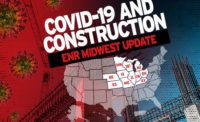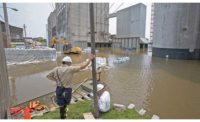Environment
Communities Prepare as Mississippi River Hits Flood Stage, Spillway Opens in Louisiana
Lack of PPE for flood first responders an issue due to COVID-19 related supply shortages

Flood protections, including a temporary floodwall made of HESCO barriers, were erected in Davenport, Iowa, with assistance from the U.S. Army Corps of Engineers' Rock Island District on April 8 in anticipation of the Mississippi River cresting 18 ft, considered major flood stage, throughout the Quad Cities area.
[For ENR’s latest coverage of the impacts of the COVID-19 pandemic, click here]
Minor flooding of some roads was already observed on April 10 as the river's height reached 16.9 ft, according to the National Weather Service. Water affects major roadways in the Quad Cities—which includes Davenport and Bettendorf in Iowa and Rock Island, Moline, and East Moline in Ill.—at around 17 ft. Moline has closed River Drive, the closest road to the river. Baton Rouge and New Orleans, La., have also taken measures to deal with high water on the river.
"The entire Quad Cities area continues to work with our emergency operations command, including fighting floods in Davenport, and their public works director is currently in charge of that portion of the EOC because they're the ones who have the experience, and sometimes, unfortunately, the bad luck to get some of this flooding," said Robert Gallagher, mayor of Bettendorf, speaking on a conference call held April 9 by the Mississippi River Cities and Towns Initiative (MRCTI). "We believe that everything will be fine at the predicted flood stages because they are very well equipped to handle that which has been projected, there's even some leeway in those projections, so I think that's important."
While the area is preparing for the flood fight with street closures and temporary barriers, Gallagher said more personal protective equipment is needed for paramedics, police officers and other first responders. The supplies that are usually needed have been depleted by the response to the COVID-19 pandemic.
"We continue to need additional PPE. Thanks to the MRCTI, we've made a group purchase and we also have local businesses who have stepped up to change their operations and manufacturing to create the needed PPE," he said. "While we continue to seek sources of PPE, we're getting deliveries" from state, federal and local sources.
Gallagher said city governments in the Quad Cities and other municipalities experiencing high water situations—including Memphis, Tenn., and Baton Rouge, La.—were connected with purchasing outlets through the MRCTI and matched with suppliers that have masks, goggles, face shields, Tyvek suits, flood coverings and hoods and gloves.
"We continue to try and link our cities with free outlets as much as possible," Gallagher said. "A lot of our cities are still hurting from having to pay the bill from last year's flooding, and a lot of our cities have not received FEMA reimbursement or all of their flood fighting from last year yet, so they are cash strapped."
While the equipment that first responders need to prepare for flooding is not the same as what medical professionals require to handle COVID-19 patients, there is some overlap. Gallagher said N95 masks with a respirator function are not needed for public works or the volunteers who may be attempting to fight the flood. Paramedics and hospital personnel dealing with injuries from potential flooding also need different clothing and gowns than needed for COVID-19 .
The Mississippi River has remained high from north to south for most of March, but hasn't seen record days in flood stage as it did in 2019, when the river crested at 22.9 ft on May 2. But, this year's levels forced the USACE to open the Bonnet Carre Spillway in Louisiana on April 3 to lower the height of the river near New Orleans. The spillway acts as an emergency valve to spill water into Lake Pontchartrain. This was the third time in 15 months that the spillway was opened and the fifth time in five years.
"The fact that it had to open back up speaks to the high river," New Orleans Mayor LaToya Cantrell said on the conference all. "Some of our infrastructure projects have been put on hold because of the high river. And given the notice by the Corps, of course we would have to stop at this particular point with our infrastructure projects."
One such halted project was the reconstruction of the 800 block of St. Ann Street in the French Quarter.




